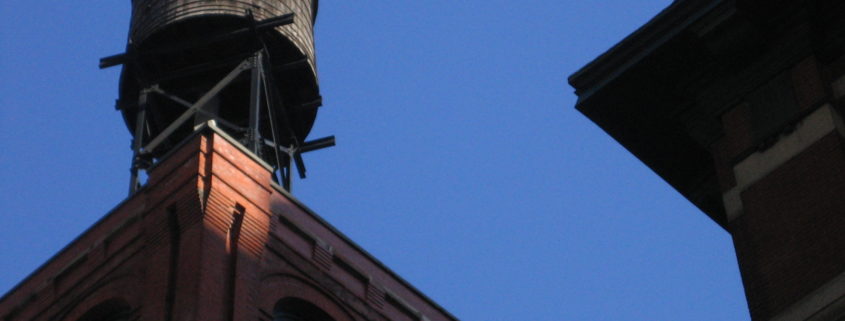New York’s typically mundane wooden water towers are actually among the most beautiful things in the world (no, c’mon, hear me out now!). Their ubiquity tells a story of tradition and longevity that stretches back over a century. In fact, their very existence is crucial to the needs of Metropolitan residents. Please indulge me while I both share a little history and present my case (through pictures) that New York’s water towers are wonderful little works of art.
After the Civil War, wooden water towers started to pop up in lower Manhattan. This happened as buildings started to get taller and taller. They were needed to reduce the strain of New York’s plumbing system, which, historically has always been very fragile.
As buildings got to be taller than 3 stories, the strain on pipes pushing water up to the top floors got to be too much. But there was a solution, if there was a tank on the roof; gravity could be used to bring water down to the top floors, thereby easing strain on the pipes. In this way, water towers functioned as a stop-gap; a way to prevent New York’s plumbing system from being gutted and replaced, already an impossible undertaking by the late 1860’s.
Instead of replacing nests of little pipes, now one big pipe could be installed to take water up to the tank on the roof; for constant replenishment.
Around 1890, a law was passed requiring all structures over six stories to have a water tower. This when things really started to take off. Two family businesses formed between 1890 and 1894. They hurriedly constructed the wooden and metal hoop tanks needed to keep pace with Manhattan’s frenzied growth. And they did a very good job, excuse me; they’re doing a very good job.
Because they’re still in business after all these years. Tradition has kept them thriving as the reins are handed down to succeeding generations. The two companies were and are the Isseks Brothers and the Rosenwach Tank Company (now Rosenwach Group). They have been doing things the same way for 120 years, only needing to update some of the machinery used to make the tanks themselves.
They are made out of cedar planks banded together with 9 or more iron bands. No caulking is used; the pressure of the water itself expands the wood enough to keep the tank from leaking. The metal hoops holding them together are spaced closer together as you get down to the bottom of the tank, owing to the increased pressure there. Then they’re capped (with occasional variation) with a conical wooden lid. That’s it, that’s pretty much what it takes, they each last about 30 years and then (and here’s the real beauty of it), they are then recycled and replaced with an exact but brand new duplicate.
When I lived in New York I always had a thing for the wooden water tower, there was a kind of romance to me about them; they seemed timeless. No one else seemed to notice them much either; they were always utilitarian and unadorned. They operated behind the scenes, seemingly performing their duties thanklessly.
And nothing in New York was made out of wood anymore, except temporary scaffolding. These tanks were made out of wood and made to last; and were the last vestiges of a city once made largely out of wood. I used to sit upstairs at my temp agency office in the ’80’s, eating their free chicken dinners and looking out the window at a couple, sitting there at eye level.
After I moved to the west coast they were one of the things I missed about New York. Visiting The City once about ten years ago, while walking around, I made a point to notice them. Soon I found myself looking for them. Then I was taking pictures of them. I couldn’t believe it, there were so many of them, and to me they were so diverse! I became obsessed.
 But it was one of those good kinds of obsessions, you know?
But it was one of those good kinds of obsessions, you know?
I looked into their history and became more fascinated still, knowing these two families did it all. There must be thousands of them in New York now, in all the five boroughs. I really admire them, the longevity of this traditional labor. People (though they may deny it) may change all the time, but, comparatively, things tend to stay the same. It’s only our relationship to the thing itself which alters over time.
It’s like those tanks, they were exactly the same as when I was a kid living in New York, neither caring nor noticing my apathy towards them. But by my thirties I had grown to love them, yet they still stood unblinkingly on their little perches, caring not that they had acquired a new fan.
If it sounds to you like they are alive, well, I guess to me they are. Don’t all things, the inanimate objects we love, kind of become alive inside the feeling we project onto it? We become attached, we remember, an instant nostalgia is born.
And the wooden water tower is a thing that was made for nostalgia.
They survived the Black Tom munitions explosions across the river in New Jersey in 1916, an act of sabotage by German agents which blew out windows in buildings all over lower Manhattan.
 They survived New York’s first terrorist attack, an explosion on Wall Street in September 1920 which killed almost forty people. You can still see the scars from the blast on the walls of the building at 23 Wall Street.
They survived New York’s first terrorist attack, an explosion on Wall Street in September 1920 which killed almost forty people. You can still see the scars from the blast on the walls of the building at 23 Wall Street.
They survived booms and busts and wars; and Manhattan’s obsessive need to continually remake itself. They survived and survive gentrification and building demolitions. New condos and office buildings go up all the time, built by hip architects that proudly shout to the world, “Look at me, I’m different!” Then someone from Isseks Brothers or the Rosenwach Group toddles up to the top and pops a traditional wooden water tower on the roof.
Sometimes they’re on tall stilts, sometimes on short ones. Sometimes they’re grouped together in bunches and sometimes they’re alone, hiding behind brick or steel enclosures. But when I’m looking for them, they usually don’t stay hidden for long.
The Starrett-Lehigh building in Chelsea has two clusters numbering over a dozen. In the Village, their numbers are so many it’s hard to keep track of them, but believe me, I’ve tried.
 I started to paint them, one after another. That lasted almost a year. One time I flew out to New York in the dead of winter to photograph as many as I could find over a three day weekend. I returned with over 600. Some of those photographs are here.
I started to paint them, one after another. That lasted almost a year. One time I flew out to New York in the dead of winter to photograph as many as I could find over a three day weekend. I returned with over 600. Some of those photographs are here.
Depending on the time of day, to me, their aspects really change. On late afternoons, casting long shadows, they can look slightly menacing, like invading alien ships, sitting and waiting for instructions. In the middle of the day, casting little or no shadow, they seem camouflaged into the backgrounds of other taller buildings behind them. Covered with snow they seem to be hunkered down, making themselves smaller. At night you usually can’t see them at all unless illuminated by the lights of another building.
While I sit here at my computer they sit up there on top of their buildings a thousand miles away, needing little maintenance and just chugging along; supplying water to buildings both old and new. They continue to assist those over-burdened labyrinths of pipes down below the city streets.
They’ll be there tomorrow and next year and long after we’re gone, hand I hope they’ll always be made by the same two companies; new generations of ever-changing people producing new generations of never-changing water towers.








